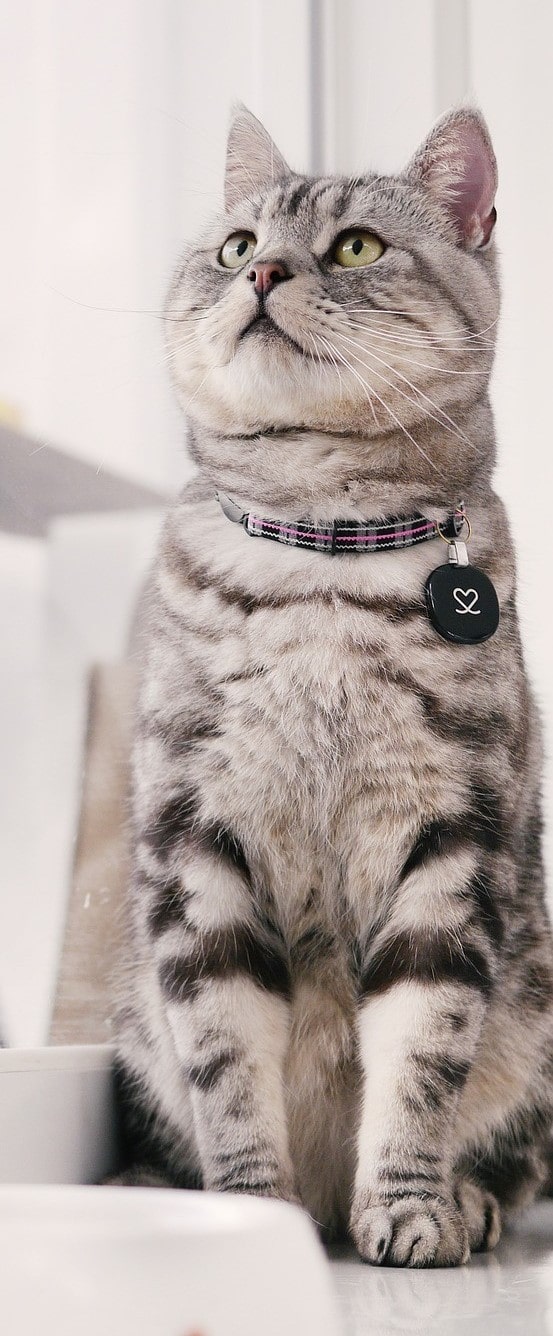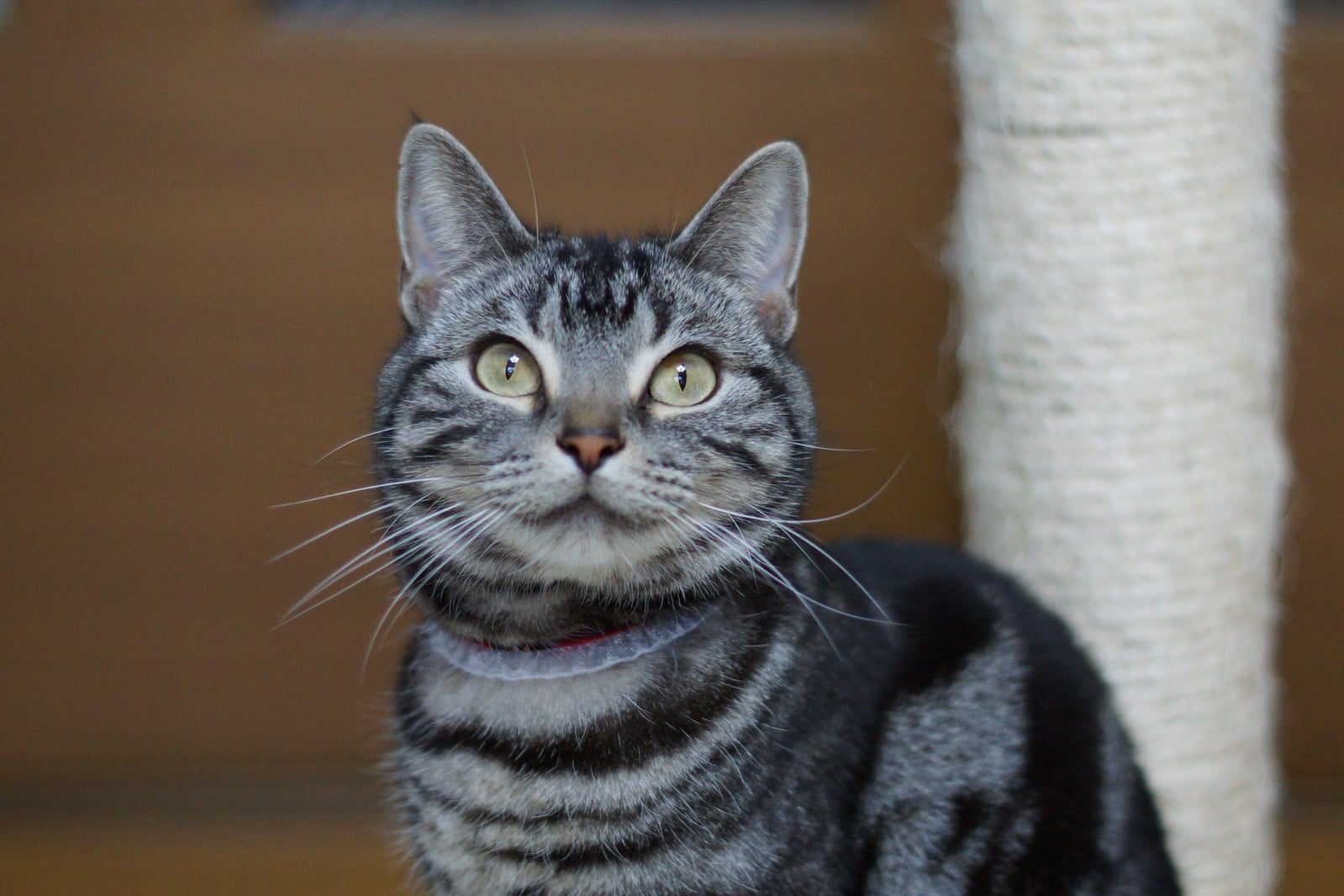Please note that some of the links below are affiliate links. This means that, at no additional cost to you, I will earn a small commission if you click through and make a purchase.
- All
- Gallery Item




Over centuries, dozens of shorthaired breeds of cats have emerged, but can all be classified under three main breeding groups: British, American, and Oriental Shorthairs. This article focuses on the American Shorthair cat, with reference to the British and Oriental shorthaired cats that have influenced the American Shorthair cat breed’s pedigree.
A domestic, pedigreed cat of European descent, the American Shorthair (ASH) cat is believed to have been brought to North America by early settlers to protect valuable goods from mice, rats, and other scavengers. Those cats that survived their sea voyages interbred and evolved to develop their own unique characteristics.
The History of the American Shorthair Cat in the USA
The exact origins of the ASH cat breed is still unknown but is thought to be borne of a cross between the European wildcat and the early Egyptian cat as the breed closely resembled the European Shorthair.
Around 945 A.D., the European Shorthair cat was introduced into Britain with the sole aim of protecting the British grain supply. Several laws were later put into effect to protect these working cats, and included fixed pricing on the value of newborns, kittens, young adults, and adept hunters. Penalties for stealing or wounding a cat was to hand over one ewe and her lamb to the injured party, while the penalty for killing a cat was enough grain to cover the cat tail-tip to head while the cat was suspended with nose touching the ground.
As witchcraft superstition spread in the eleventh century, interest in cats as pets or working animals died out. Cats and kittens were burned at the stake along with their helpless owners. Fast-forward a few centuries, and the inherent value of cats was once again recognized, this time in the fifteenth century.
Reports indicate that the breed of cat brought over to the US from Europe on the Mayflower and other settler ships in the sixteenth century were identified as the European Shorthair breed. The mice and rat populations at the time were so severe a problem that more and more of these European Shorthair cats were brought over to the Americas to keep the rodent population under control.
Selected more for their natural hunting abilities and their rugged hardiness, the interest in American-bred shorthaired cats grew. In 1749, locally-bred shorthair cats were introduced to Pennsylvania to control an overwhelming rat plague that had broken out in the area.
During the San Francisco rat plague of 1884, shorthairs sold from anywhere between $50 to $100 each. Then, during the 1849 San Francisco Gold Rush, miners were happy to pay $50 each for proven mice and rat hunters, specifically the cats that had arrived on the ship S. S. Ohio.
A popular cat, interested breeders set up a selective breeding program around 1900 to develop and nurture the best qualities of the ASH cat, who had until then been bred for their ability to withstand extreme cold conditions and their efficient hunting skills.
To determine a broad genetic base for the ASH cat, several cats of the same breed but from different countries of origin were analyzed. Pedigrees were not necessary until other breeds were imported in the late nineteenth century.
Purebred by default, there were so few recognized shorthaired breeds at the time that “Shorthair” was considered sufficient breed identification. Originally known as the Domestic Shorthair, the first official shorthaired cat to be named an American Shorthair was Buster Brown, in 1904.
In 1966, the domestic shorthaired breed was renamed to the American Shorthair cat to better represent its “all-American” origin and to differentiate it from all the other shorthaired breeds. Breeders wanted to maintain the resemblance to the domestic shorthaired cat, but the British Shorthair was chosen as a crossbreed for the sake of elegance.
ASH catteries began popping up everywhere when cat lovers realized how affectionate, useful, hardy, and healthy the breed was. It also didn’t hurt that the ASH cat was winning cat show after cat show at the time.
In 2012, the ASH cat was ranked #7 on the Cat Fanciers’ Association Board.
Today, the ASH cat remains amongst the most common of cat breeds and is a firm family favorite in the US, Japan, and Canada. In Europe, some organisations refuse to acknowledge the breed so it is still considered very rare.
The ASH cat is ranked #4 on the 2020 Cat Fanciers’ Association Board, and is regarded as a pedigreed breed accepted by all North American cat registries.
The personality of the American Shorthair cat
Generally, a happy cat, the ASH cat’s popularity grew due to their flashy colors and bold patterns, as well as their natural hunting abilities.
Known as a very intelligent, independent, and very courageous cat, the ASH cat is playful and friendly with other breeds of cats and well-known for its tolerance of other pets. A very lazy cat that doesn’t talk all that much but it needs a significant amount of attention, the ASH cat is nevertheless very affectionate towards owners and caregivers, and seems to listen when spoken to.
Physical characteristics of the American Shorthair cat
The ASH cat’s coat is short, thick, even, and hard in texture, with many colors and patterns that include solid, shaded, smokey, and more. ASH cats are well known for their brown or gray tabby coats but may present with unique colors and patterns.
The female ASH cat varies in weight from 6-12lb, whereas the male is larger in weight, coming in at 11-15lb. The average ASH cat measures between 12-15in.
It should be noted that the ASH cat is not hypoallergenic and you’ll need to groom your cat quite often.
Caring for the American shorthair cat
Grooming
The ASH cat has a low-maintenance, short coat that comes in over 80 known variants, therefore brush as much as needed for a healthy shine. ASH cats generally have good teeth, and brushing them at least twice a week will maintain their healthy glow and prevent periodontal disease.
Check ears weekly for wax, build-up, pests, or any signs of infection, and clean when necessary with a soft, damp cloth or a cotton ball that’s dipped in a 50/50 mix of cider vinegar and warm water. Earbuds (cotton swabs) are not recommended as these can damage or hurt the inner ear lining.
Cats are quite finicky and particular about where they do their business, so keep the kitty litter box as clean as possible at all times to avoid other places in the house being used as a litter box instead.
As lifespans go, the ASH cat compares quite favorably with other breeds. With good care and proper nutrition, the ASH cat has a life expectancy of approximately 15 years or more, thanks to their lean bodies and lowered chance of disease.
Feeding
Known as a hunter breed, the domesticated working cat has a naturally muscular and heavy-set body that needs good nutrition to maintain it. ASH cats thrive best when fed a diet with enough energy, protein, fats, and essential nutrients for their lean bodies.
Most healthy adult and senior cats of average weight need about 280-360 calories daily. as with all living things, essential nutrients and vitamins are needed to boost the ASH cats’ gut and immune health. These macronutrients include fats, carbohydrates, and proteins
Preventing an overweight cat from developing obesity-related diseases (like feline diabetes or feline heart disease) begins with a diet that is low in unnecessary fats. Commonly found in unhealthy cat-food fillers, limiting intake of these dangerous fats can help prevent health problems and improve your cat’s well-being and chances of a longer life.
Cat foods that are enriched with essential fatty acids (such as Omega-3 and Omega-6) are always great options to keep a cat’s coat healthy.
Carbohydrates are a vital aspect of a cat’s nutrition, especially for those that need modified carbohydrate intake. Carbohydrate intake is dependent upon energy levels, but an active breed like the ASH cat would probably require a little more carbs than the usual couch potato.
Prone to obesity, indoor ASH cats should have their diets monitored, and placed on a more sustainable diet, such as grain-free, low carbohydrate cat food if necessary.
Muscles rely on protein for growth and maintenance. ASH cats are best described as stocky and will need a diet high in protein. Choose high-quality, real, fresh meats, where possible.
Note: To prevent obesity, it’s best to measure food instead of free-feeding an ASH cat.
What foods should American Shorthair cats avoid?
Onions, garlic, raw eggs, meat or bones, chocolate, alcohol, and caffeine (like the last two had to be mentioned!). I can recommend Meow Mix Original Choice Dry Cat Food as a good all-round food for your American shorthair cat.
Common diseases of the American shorthair cat
The American Society for the Prevention of Cruelty to Animals (ASPCA) recommends that ASH cats be kept indoors for safety reasons, to protect them from catching contagious diseases or infections, picking up pests (like fleas and ticks), or from being hurt by other animals. ASH cats are very susceptible to summer’s heat, and should be kept indoors as much as possible to prevent dehydration.
Regular vet visits can ensure your ASH cat’s weight is monitored and adjusted if needed. Additionally, your vet is better placed to diagnose any medical issues, discuss your concerns, and to give your cat the vaccines and deworming needed to keep them at optimal health.
Genetic traits may result in breed anomalies, but ASH cats are generally known to be healthy. Mixed breeds will be more prone to genetic diseases, whereas a purebred will have a lowered risk of developing feline illnesses and infections. Of unknown origin but thought to be genetic in cause, hypertrophic cardiomyopathy is a type of heart disease most common in cats.
Hypertrophic cardiomyopathy can appear anywhere from around 3 months to 17 years old, but most cats tend to already be middle-aged when diagnosed. Hypertrophic cardiomyopathy is more common in males than females, where symptoms could include difficulty breathing, bodily weakness, or paralysis in the back limbs.
Alarmingly, fluid may also build up in the lungs, as well as in the chest wall. For those who are only slightly affected, your vet should look at improving cardiac and lung function, as well as at reducing any blood clots that develop. For those cats not severely affected by hypertrophic cardiomyopathy, there is good reason to expect a long and happy – though well-managed – cat life.
If not exercised regularly, the ASH cat is liable to become obese, where excess weight is a critical factor in later development of feline diabetes, feline arthritis, and other life-threatening or contagious diseases. Your breeder will be able to answer any queries you have about health problems in the cat’s breed line, and what testing has been done so far.
Five quick facts about the American shorthair cat
Are American Shorthair cats friendly?
Do American Shorthair cats like to cuddle?
Does your American Shorthair cat know it’s name?
Why does your American Shorthair cat follow you to the bathroom?
Has an American Shorthair cat ever lived in the White House?
India “Willie” Bush was an American Shorthair cat owned by former U.S. President George W. Bush and First Lady Laura Bush. The black cat was born on July 13, 1990 and lived in the White House with the Bush family until she passed away on January 4, 2009.
But India was not the first White House cat. Over the years, there have been quite a few presidents who loved cats:
● President Abraham Lincoln (1861-1865) – owned the first cats (named Tabby and Dixie) to occupy the White House
● President Rutherford B. Hayes (1877-1881) – owned the first Siamese cat to arrive in the US, (named Siam), as well as a kitten named Piccolomini.
● President Theodore Roosevelt (1901-1909) – owned a six-toed cat (named Slippers), and Tom Quartz (who was named after a cat in Mark Twain’s book entitled Roughing It
● President Calvin Coolidge (1923-1929) – amongst their numerous pets, the Coolidges also owned Tiger, Blacky, Bounder, Timmie, and a bobcat named Smoky.
● President Gerald Ford (1974-1977) – Ford’s daughter Susan owned Shan Shein, a Siamese cat
● President Jimmy Carter (1977-1981) – Carter’s daughter also owned a Siamese cat, named Misty Malarky Ying Yang
● President Bill Clinton (1993-2001) – originally owned by the Clintons, Socks was a well-known and beloved first cat, who was eventually adopted by the president’s secretary at the time
Other cat breeds
Sources
- Prestige Animal Hospital. American Shorthair: More than just a Common Housecat. Retrieved November 1 2020 from https://www.prestigeanimalhospital.com/services/cats/breeds/american-shorthair
- Vetstreet. American Shorthair. Retrieved November 1 2020 from http://www.vetstreet.com/cats/american-shorthair#1_ugw20zmq
- ASPCA. American Shorthair Cat Facts. Retrieved November 1 2020 from https://www.aspcapetinsurance.com/resources/american-shorthair-cat
- Petonbed. American Shorthair. Retrieved November 1 2020 from https://petonbed.com/american-shorthair/
- CFA. The American Shorthair. Retrieved November 1 2020 from https://cfa.org/american-shorthair/
- Animal Health Center. American Shorthair. Retrieved November 1 2020 from https://animalhealthcenternh.com/client-resources/breed-info/american-shorthair/
- Alken Murray. History of the American Shorthair cat. Retrieved November 1 2020 from https://www.alken-murray.com/ASH-history.html
- The Holiday Times. American Shorthair cat. Retrieved November 1 2020 from https://www.holidogtimes.com/cat/cat-breeds/american-shorthair/
- Reader’s Digest. 12 Cat Breeds That Get Along with Dogs. Retrieved November 1 2020 from https://www.rd.com/list/cat-breeds-that-get-along-with-dogs/




